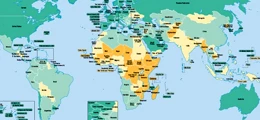
Every year, the analytical classification groups all economies into four categories: low income countries (LICs); lower middle income countries (LMICs); upper middle income countries (UMICs); and high income countries (or HICs). This year we will update the classification using 2013 data, but we will not make any change to the methodology.
Analytical classifications are used extensively outside the Bank
The review of the analytical classification is on-going. It has revealed – as some commentators have pointed out – that the analytical classification is used far more extensively outside the World Bank than we had previously known, and in many cases for resource allocation purposes or as the basis for policy decisions. The classification was originally only intended for analytical purposes, such as comparison and aggregation, but it is clear that usage has extended beyond that. Given this, and the fact that the classification is based on decisions taken in consultation with the World Bank's Executive Board, it would not be appropriate to suspend the classification whilst our review is ongoing. But, so that users can determine whether the classification is fit for their purpose, we have updated our description of how the classification is produced, what variables it uses, and how the cutoffs are determined. This now includes references to the key discussions which led to the determination of the current thresholds and the agreed methodology.
The difference between the analytical and operational classification
One important point that we'd like to again stress: our review is focused on the analytical classification, and not the per capita income guidelines that are used as one factor in the process of determining access to different World Bank lending windows and repayment terms (sometimes referred to as the "operational classification"). This continues to confuse some users – and it's not surprising; both systems draw on the same dataset of GNI per capita estimates. The ranking of countries by income per capita (and the income categories) used to inform operational policy can be found in Annex C to OP3.10 on this page – but it should be noted that other factors, particularly creditworthiness, play dominant roles in the decisions on lending eligibility and repayment terms (see Annex D of OP3.10).
The two classifications do not use precisely the same category thresholds, though there is some overlap. The per capita income guidelines for operational purposes came first, and were developed for use in the Bank's operational work. The analytical classification made use of the per capita income guidelines; and its current formulation – including the choice of category thresholds – is explained in a paper discussed by the World Bank's Executive Board in 1989.
Some proposals from users
We'd like to highlight some proposals that have often been suggested by users of the analytical classification.
The first is the use of currency conversion factors based on purchasing power parities (PPPs) rather than market exchange rates. The latest PPPs from the International Comparison Program (ICP) have only been released recently, but we are yet to test the impact of the suggested change with the latest data. One issue with this approach – and the reason that this has not been adopted in the past - is that we do not yet have stable and frequent annual estimates of PPPs from the ICP program.
The second proposal is that a "relative" classification may be more useful for analytical purposes – dividing countries into equal groups each year on the basis of an appropriate methodology, such as ranking or clustering. A simple and attractive approach would be to continue to use the GNI per capita estimates collected for the per capita income guidelines as the ranking variable, and group countries into quartiles – with some additional procedures to minimize volatility. This would eliminate the need for fixed cutoffs to define categories, but there are drawbacks typical of relative classifications: the cutoffs effectively become determined by the ranking, and so countries fall into different groups as a result of both their own rate of change and the rates of change of all other countries.
A third proposal is to replace the analytical income classification with the World Bank's operational lending categories for grouping countries and calculating summary statistics accordingly.
We plan to continue to review the analytical classification in the coming months, and to consult further with users and the academic community. Please provide feedback and comments; we are especially interested to hear about the uses to which the classification is put, and the potential implication of any change, including the proposals described above.



Join the Conversation